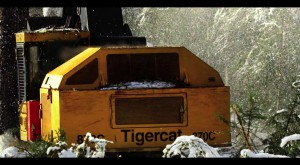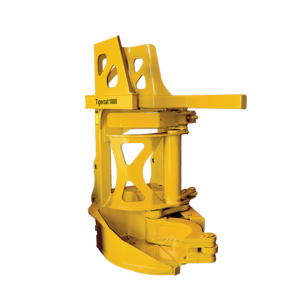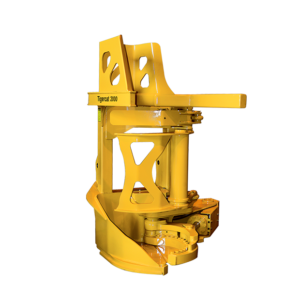– Paul Iarocci
To discover the origins of the Tigercat shear, we have to jump in the time machine and travel back to 1994 – the year that Richard Nixon died and CIA analyst, Aldrich Hazen Ames was convicted of spying for the Soviets. Nelson Mandela is elected President of South Africa. Drama unfolds between rival figure skaters and Colombian soccer player Andrés Escobar is murdered for scoring against his own team in World Cup. Baseball players strike and George Foreman becomes the oldest heavyweight champion. And then there is O.J. Simpson. Meanwhile, Tigercat and the World Wide Web are in their infancy and poised for bigger things.
In 1994 Tigercat is quietly, yet briskly building drive-to-tree feller bunchers and developing the 853E track buncher in Brantford, Ontario. The drive-to-tree population – which numbers 200 by the year’s end – stretches from Virginia to Texas. Already the machines are recognized as more reliable and productive than anything else on the market. However, in small stem plantation applications, Tigercat’s engineers feel that the productivity of the machine could be further enhanced if only the felling head could accumulate more trees per cycle. They also believe that the market is ready for a high performance shear head. So the company sets a precedent that has since become an overarching design philosophy: when Tigercat is relying on an outsourced component and that component is not measuring up, it is time to build a better alternative – in house.
So Tigercat team member, John Kurelek, literally a legendary figure in the industry, sets out to design a high capacity bunching shear. The end result is the 1800 series and later, the 2000 series Tigercat shears. Both heads are still in production today, albeit with twenty years of improvements and enhancements integrated into the design.
Today’s shears have right hand side accumulation pockets (switched in 2013 to match the bunching saws) for improved visibility and sight lines for track carrier applications. The accumulation area for the 1800 series has grown from 0,455 to 0,553 m² (4.9-5.95 ft²). The 1800 is available with an optional 115 mm (4.5 in) bore cylinder for faster cycles in stems under 35 cm (14 in) in diameter. The optional quick cycle cylinder uses a 75 mm (3 in) rod with a base end cushion to eliminate shocks associated with the faster opening time. In these stem sizes – common in biomass harvesting – cycle times are 40% faster compared with the standard 152 mm (6 in) cylinder with a 90 mm (3.5 in) rod.
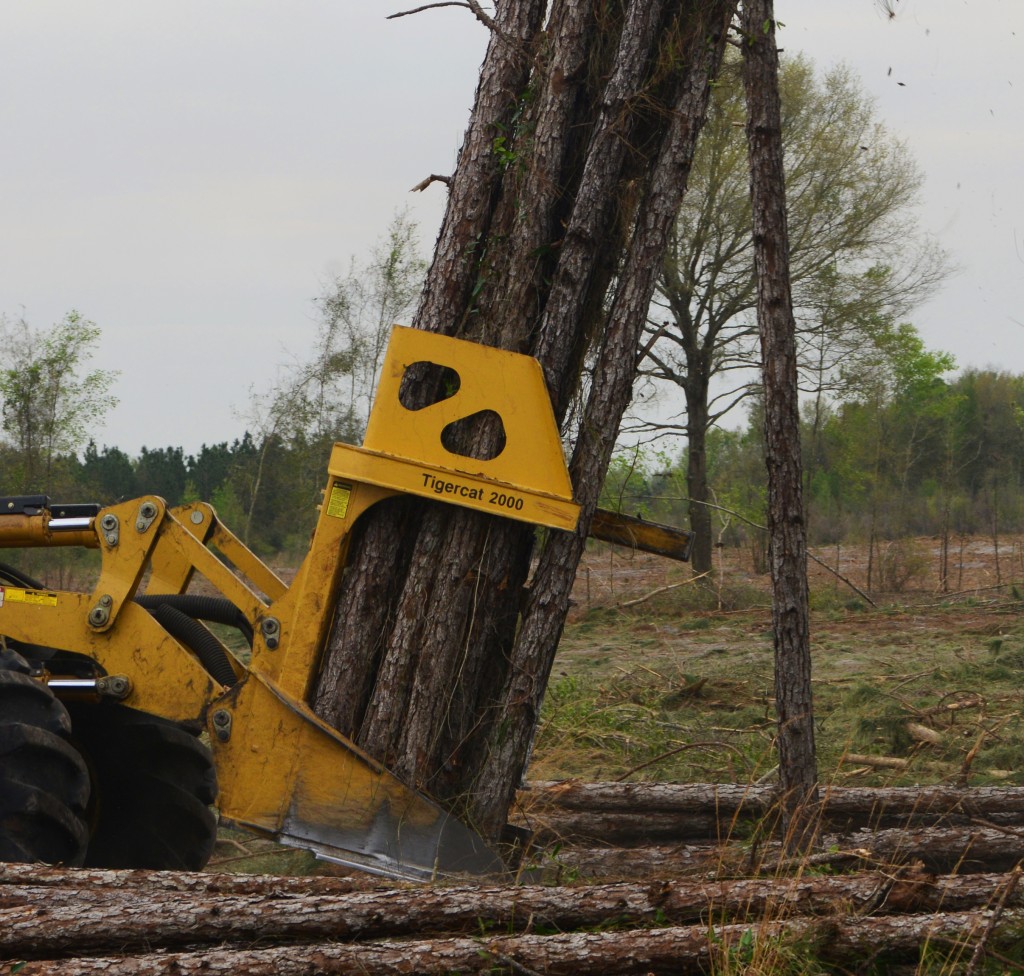
Packed to capacity. A really good operator can cut a ten tree bunch cycle nearly as quickly as a saw and without the vines. Many believe that the positive lock on the tree as it is severed allows for larger, more parallel bunches.
Built for larger diameter trees, the 2000 series has a capacity of 0,5 m² (5.38 ft²) measured over the accumulating pocket and fixed blade. The 2000 uses a 165 mm (6.5 in) bore cylinder with the larger 90 mm (3.5 in) rod. Another important enhancement to both models, undertaken in 2013, was the shift to tapered roller bearings in the shear pivot joint, providing very precise blade alignment and consequently, a higher quality cut.
Shears are a very specialized attachment, suited mainly to pulpwood or biomass harvesting and smaller, relatively consistent stem diameters. The reality is that many contractors cannot guarantee an ongoing supply of timber that meets the criteria. However, there are certain geographic markets, such as South Australia and Western Australia where the contractors are quite enthusiastic about Tigercat shears mounted on 845C and 855C track carriers. Both regions are home to a large volume of homogeneous, small diameter blue gum plantations with difficult soil conditions. According to factory representative for Australasia, Glen Marley, “High cutting production, reliability, low maintenance, and longevity has been proven over and over again in the local conditions, where disc saws have been avoided mainly due to highly abrasive soil conditions, rocky terrain and the higher risk of associated bushfire dangers.”
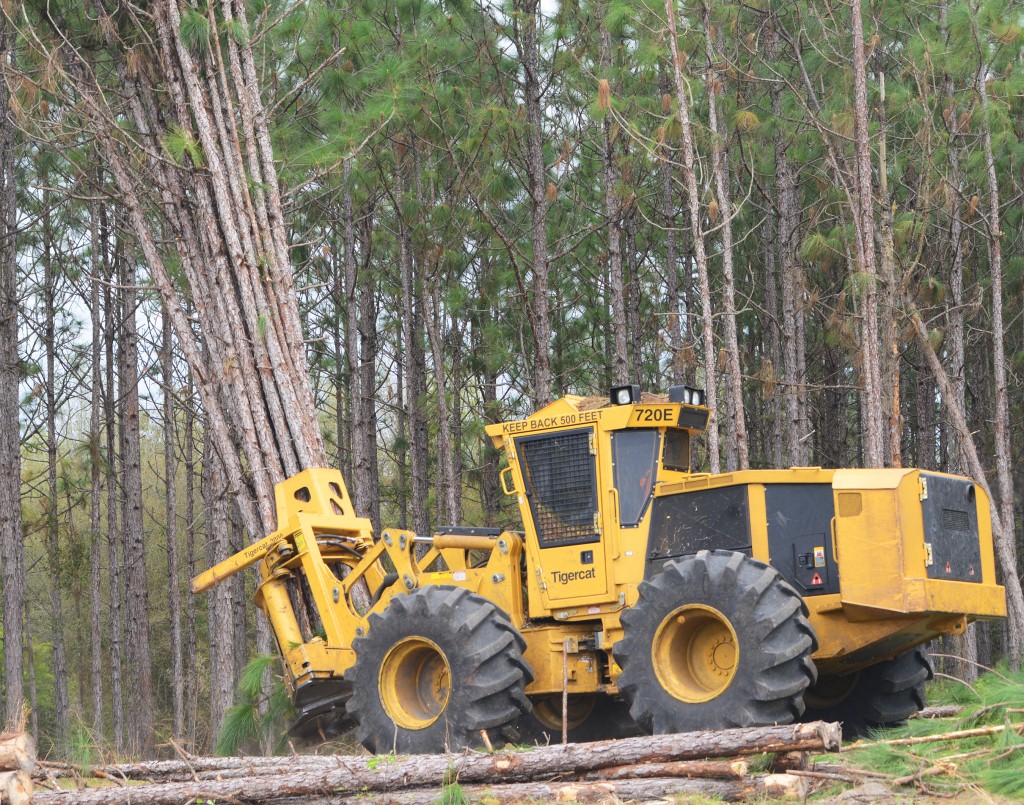
A Tigercat 720E, piloted by James Williams, throwing down a bunch. With deep operating experience, James has become a big fan of the Tigercat shears.
Another market where Tigercat shears dominate is north Florida. The Gulf region is flush with pine plantations situated on extremely sandy soil. BTB recently did a quick tour around the areas of Perry and Live Oak to see a couple of Tigercat’s latest generation shears in action. First stop was the operation of Jeffrey Boland, owner of Boland Timber Co. The jobsite was a beach-like tract of marginal quality pine. The plantation was carpeted in palmetto. The green wood is transported full-tree to the Buckeye pulp mill in Perry, Florida where it is chipped for fuel.
There is a subtle difference in the way the shear cuts a tree as opposed to a saw. When a hot saw drives through a tree, the cut stem is loose and sitting on the butt plate for an instant. With a shear, the operator wraps the grab arm around the trunk as it is severed, creating a constant positive lock on the tree. Many operators including Boland’s 720E driver, Punky Hampton, feel that this difference allows them to pack more trees into the head than an equivalently sized saw, eliminating a significant amount of machine travel over time. If you cut ten trees instead of nine over ten cycles, you eliminate an entire bunch cycle along with the associated travel to and from the bunch pile. Cutting two extra trees per cycle makes an even more profound difference, roughly eliminating every sixth cycle.
Some criticize the shear saying the open-close cycle time is too slow but as Jamie Boland, Jeffrey’s son says, “You don’t need to open the shear all the way. Some people say they are slower but we are never waiting on the cutter. You couldn’t give me a saw.”
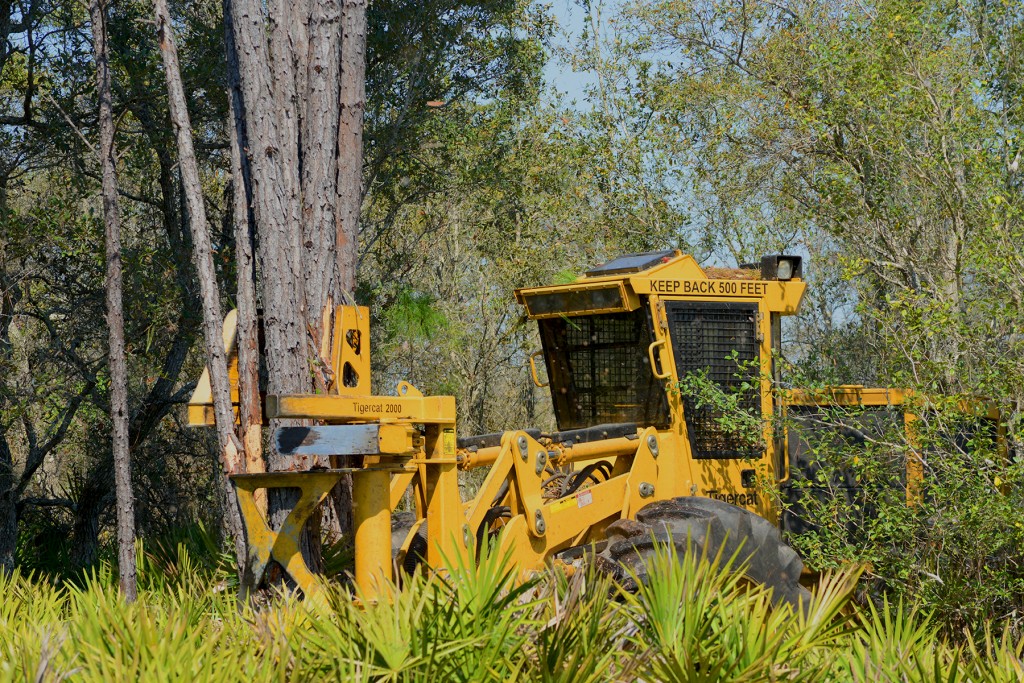
One of Boland Timber’s four Tigercat shears amongst the palmetto on a beach like tract near Perry, Florida.
For the Bolands, it’s the maintenance costs that make the difference. “We change shear blades once or twice a year. We keep them sharp and we don’t cut a lot of big timber. It costs $1,000 a month for teeth [when you are working] in the sand, including bolts every other time, plus labour and downtime.” Then one must factor in disc wear, which the Boland’s value at about $1.50 per hour. “We don’t know anything different but we do know that a saw will not survive the sand. These things are worth their weight in gold down here on the Florida Gulf Coast.” says Jamie. The Bolands figure that one shear can last the life of two tractors, “and now with the new tapered roller bearing, it could last even longer,” Jeffery surmises.
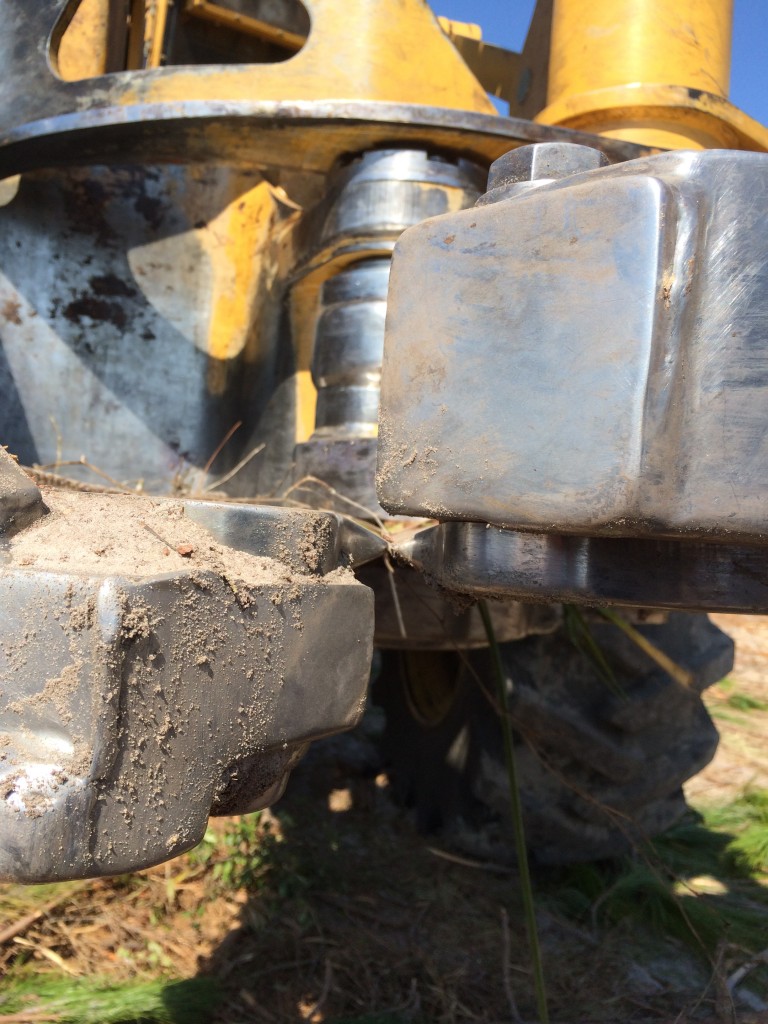
The new tapered roller bearing design allows the blades to remain in a very precise alignment for improved cut quality and reduced maintenance.
Jamie and Jeffery cite another advantage: “We get the tree not the vine.” Disc saws tend to pick up the vines to a much greater extent than the shear heads and they remain entangled in the trees through the skidding process, eventually winding up on the landing. It is a real problem at the deck for the loader operator and the use of the shear tends to speed up the loader productivity which in turn improves the productivity of the entire system.
Punky’s machine burns 21, 5 L/h (5.68 gph) and cuts 1 770 to 2 120 tonnes (1,950-2,340 tn) per week. Tigercat engineering estimates that it takes 40 horsepower just to turn a saw blade, without factoring in cutting trees. This translates conservatively to 5-8 L/h (1.3-2 gph) in fuel savings by running a shear over a saw.
Second life
In 2008, Johnny Boyd, Tigercat district manager and Frank Corley, a prominent forestry professional based in Greenville, Alabama sourced a used 1800 shear and for less than the price of a new disc saw blade, rebuilt it and installed it on a 724 buncher. The operators, leery at first, caught on pretty quickly as they realized the vines don’t get tangled and there is far less maintenance compared with a disc saw. Now, when Frank’s operators have a choice between a shear or saw, they always choose the shear. Other contractors (and competitors) took note and now the practice of refurbishing old shears has really caught on – so much so that even John Deere dealers in the Florida Gulf region buy used Tigercat shears. It is a common occurrence in the area to see brand new Deere feller bunchers with rebuilt Tigercat shear heads. This really demonstrates the consensus that the Tigercat shear, in any of its incarnations, is the ultimate head for sandy plantations.
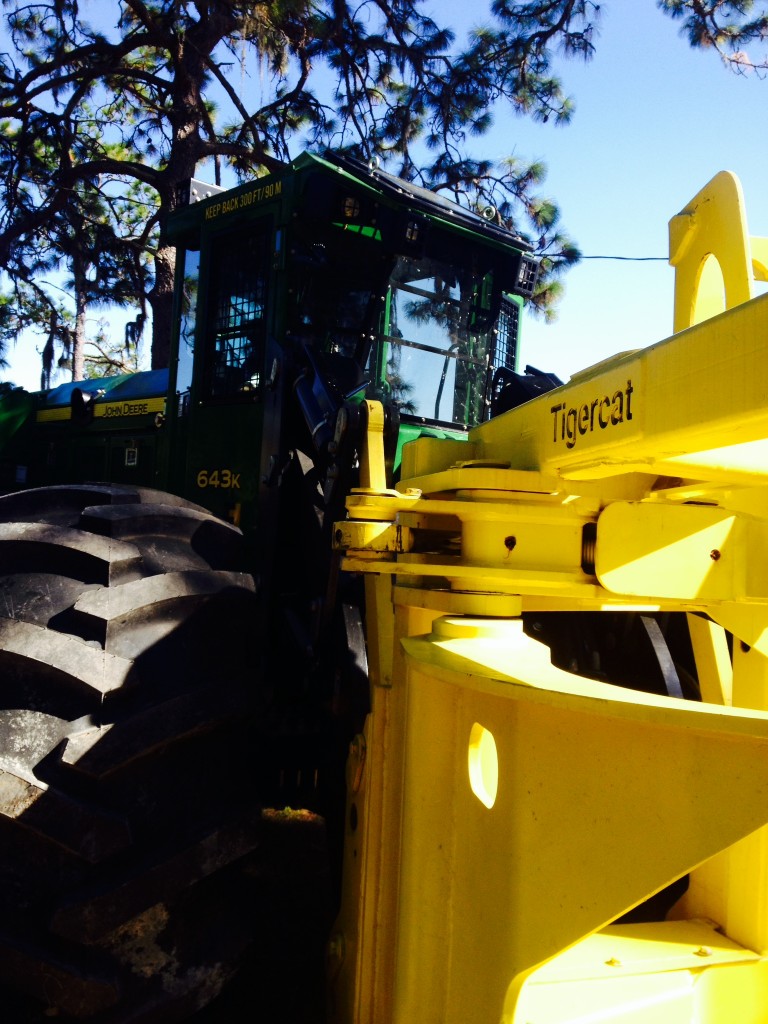
The Deere dealers in north Florida are buying up used Tigercat shears, refurbishing them and installing them on brand new Deere feller bunchers. (Photo courtesy of Shawn Webb)
The second site BTB visited was a Williams Timber Inc. operation near Live Oak, Florida. Again, the plantation was situated on fine, sandy soil. Operator, James Williams, who comes from a family with deep ties in the north Florida logging community, is another expert operator who previously ran hot saws on both wheel and track feller bunchers in varied conditions – including swamps and hills. James cuts the stems at ground level. Due to the taper at the base of the tree, this is a harder job for the shear but it improves the fibre yield and does not slow production. He is extremely fast and efficient in his movements, often able to cut two trees before closing the clamp arm. We timed some cycles and saw him achieve a ten tree bunching cycle in 34 seconds. “I like the shear,” he says. “I was a [Caterpillar] man and you won me over. It didn’t take me long to get used to the shear and the new style packs a lot more wood. It is hard to beat a Tigercat.”







